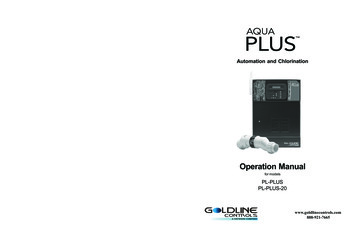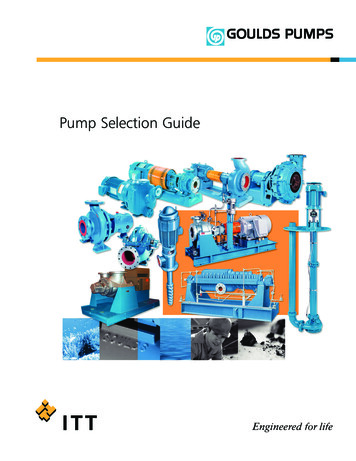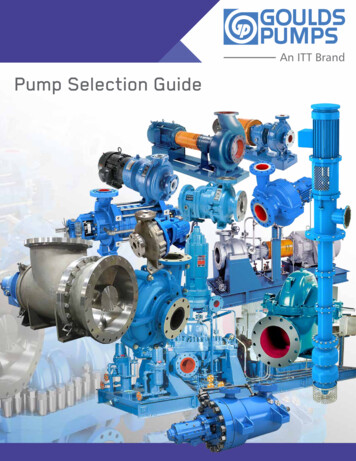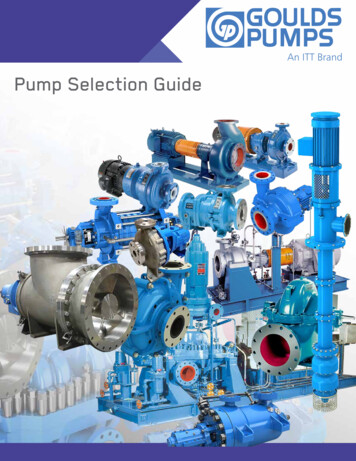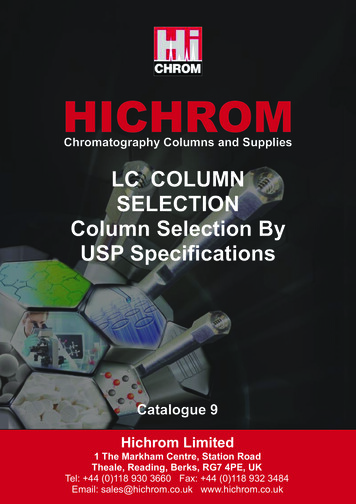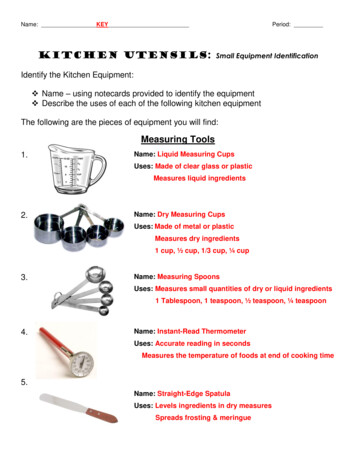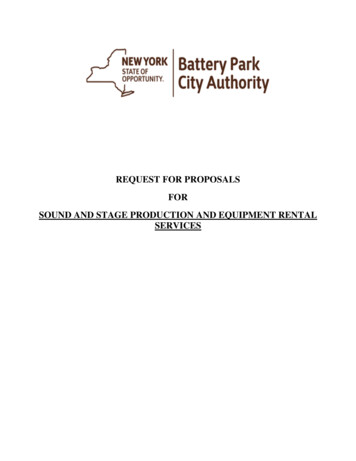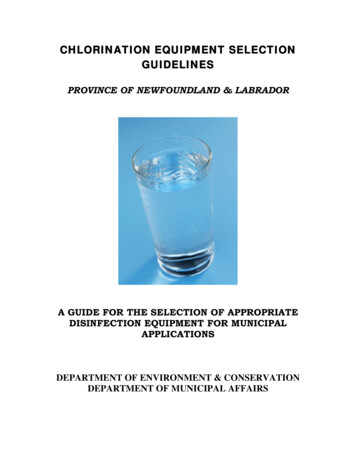
Transcription
CHLORINATION EQUIPMENT SELECTIONGUIDELINESPROVINCE OF NEWFOUNDLAND & LABRADORA GUIDE FOR THE SELECTION OF APPROPRIATEDISINFECTION EQUIPMENT FOR MUNICIPALAPPLICATIONSDEPARTMENT OF ENVIRONMENT & CONSERVATIONDEPARTMENT OF MUNICIPAL AFFAIRS
ACKNOWLEDGEMENTSThese guidelines were developed to address the issue of disinfection design and equipmentselection for the Province of Newfoundland and Labrador. The two lead Departments involvedwere the Department of Municipal Affairs, Engineering Services Division and the Department ofEnvironment & Conservation, Water Resources Management Division.The authors of these guidelines were:Herbert CardRon GouldingChris BlanchardBrad PenneyGerald RumboltAngus BradleyDesign Approval SpecialistEnvironment and ConservationDesign Approval SpecialistEnvironment and ConservationDesign Approval SpecialistEnvironment and ConservationWater & Wastewater Systems SpecialistMunicipal AffairsWater & Wastewater Systems SpecialistMunicipal AffairsWater & Wastewater Systems SpecialistMunicipal AffairsThe authors would like to thank Doris Penney with Municipal Affairs Finance for preparing theLife Cycle Cost tables. Appreciation is expressed to Haseen Khan, Manager of the WaterResources Management Division of the Department of Environment and Conservation and theRegional Engineers with Municipal Affairs for their valuable comments and input to theguidelines.Page 2 of 14
CHLORINATION EQUIPMENT SELECTIONTABLE OF CONTENTS1. Table of Contents22. Acknowledgements33. Executive Summary44. Purpose55. Background/History56. Chlorination System Types6i.ii.iii.Gas EquipmentHypo-chlorination EquipmentRelated Public Water Supply Information6667. Selection Criteria7i.ii.iii.iv.7777Capital CostO & M CostLife Cycle CostPopulation8. Table A, Hypo-Chlorination89. Table B, Gas Chlorination910. Flow Rate & Chlorine Demand1011. Chart A, Dosage vs Flow1012. Operator Requirement & Knowledge1013. Hazard/Safety1114. Table C, Chlorine Gas to Hypo-chlorite Safety Comparisons1215. Water Quality Parameters & Corrosion1316. System Optimization1317. Conclusion14Page 3 of 14
EXECUTIVE SUMMARYA Committee with representatives from the Departments of Environment and Conservation andMunicipal Affairs was formed to research information on gas and hypochlorite disinfection equipmentand prepare a report of their comparison and make recommendations on preferred types of equipment.The comparison would concentrate on gas and hypochlorite equipment as these two types of disinfectionequipment are the predominant types in use in the province.During the research phase it was determined that, in the past, equipment selection was based primarily onpopulation only. This resulted in some communities with systems that were unsuitable, ineffective, andconsequently, fiscally demanding to operate.The criteria used in this report to compare both gas and hypochlorite equipment types are: (i) population;(ii) capital cost; (iii) operations and maintenance cost; (iv) life cycle cost; (v) flow rate; (vi) chlorinedemand; (vii) operator requirements and knowledge; (viii) hazard/safety; (ix) water quality parameters;(x) corrosion; and, (xi) system optimization.The report concludes that the selection of disinfection equipment for any community should be based onspecific circumstances relevant to the community under consideration. The two main factors which havethe most affect on the selection of disinfection equipment are flow rate and chlorine demand.Page 4 of 14
PURPOSEThis document provides a generalized approach that is intended to be a concise yet inclusive coverage ofdesign criteria to be considered by designers and owner/operators of water supply systems in choosing themost appropriate form of disinfection equipment for their needs.It is recognized that many forms of disinfection are available and technologically viable for manyapplications in either a primary and secondary application or combinations thereof. However, chlorinationis recognized as the most feasible and practical application and is used in its various forms throughoutdistribution systems across the province.The purpose of this document is to provide relevant information to enable an informed decision of themost appropriate choice of either hypochlorite or gas disinfection equipment. This decision should not bemade lightly or quickly or in isolation nor should it be based on rigid or prescriptive factors. Some of thefactors are service population, affordability, system hydraulics, demographics & flow requirements, waterquality, operational requirements, and safety issues. These factors and others need to be considered in abroad scope decision making approach that is inclusive of all pertinent factors.BACKGROUND/HISTORYFunding programs of the Department of Municipal Affairs have been made available through Capital andInfrastructure Works Programs including the Disinfection Assistance Program. Funding for theinstallation of new disinfection equipment and the upgrading of existing systems have been given highpriority in an attempt to help communities provide safe potable water for their consumers.It has been the experience of the Department of Environment and Conservation and the Department ofMunicipal Affairs that a number of communities can not afford or are not willing in some cases to operateand maintain disinfection systems for a number of reasons. These range from the perception thatchlorinated water causes cancer, it creates objectionable taste and odour problems and disinfectionsystems are too expensive to operate.The unwillingness of communities to operate their disinfection systems is more prominent forgroundwater supplies. Councils and consumers feel that groundwater does not require any treatment.An engineering cost benefit analysis of gas versus hypo chlorination was undertaken in 1994. The studyconcluded that over a 10 year period, gas equipment would be more economical. This was based on anumber of assumptions including the fact that the community would be fully serviced over the life cycleof the system and population would increase. These assumptions were misleading and incorrect and, as aconsequence, a number of smaller communities were saddled with gas equipment that remained in serviceuntil problems were experienced. Also, based on these assumptions, gas equipment was sized to meetprojected demands and resulted in oversized systems that could not adequately handle low flowconditions.The issue of installing gas chlorination equipment for smaller communities that cannot afford toadequately operate and maintain them has again been brought to the forefront and is the basis for theformation of this committee.Page 5 of 14
Chlorination System TypesThe majority of disinfection systems installed consist of either gas chlorination or hypo chlorination.Gas Equipment – consists of 68 kg (150 lb) or 908 kg (2000 lb) containers, chlorinator, weighscales, switchover modules, injectors, vacuum lines, solution lines, diffusers, booster pumps and aflow meter. Safety requirements are mechanical ventilation, passive ventilation, warning devicesand alarms, panic hardware for doors, showers and eye washes. A separate air tight room isrequired for chlorination equipment. 100% of chlorine gas is available for disinfectionHypo-chlorination Equipment – consists of a solution tank, a metering pump, a solution lineand a flow meter, and possibly storage tank. Safety requirements include an eye wash station,protective clothing and goggles. A separate room is not required. Hypo chlorination solution isgenerally made at a 12% concentration so only 12% of the solution is available for disinfection.There is a powder version (HTH) that has 65% chlorine available for disinfection. This version isusually used in remote areas where there is no delivery during the Winter season. Therefore, thepowder version is the preferred method of disinfection in remote areas due to the fact that sodiumhypochlorite has a recommended shelf life of three months while the powder version remains at65% until mixed.Related Public Water Supply InformationAll of the data below has been generated by the Department of Environment and Conservation’sPublic Water Supply Database as of April 2005 and Boil Water Advisories (BWA’s) as of May31, 2005. There are 533 Public Water Supplies There are 160 gas systems serving 348,846 population, 17 of these systems are on BWA There are 2 gas systems with hypochlorite booster stations serving 5,750, 0 are on BWA There are 284 hypo systems serving 57,421 population, 137 of these systems are on BWA There are 10 hypochlorite (powder) systems serving 4,946 population, 1 of these systems ison BWA Total number of chlorination systems 456 Total population serviced with disinfection systems 416,963 % of systems that are gas 35.5% % population served by gas 85.04% 354,596residents % of systems that are hypo 64.5% % population served by hypo 14.96% 62,367residentsTotal BWA 155Of the 155 BWA’s, there are 17 gas systems on BWA which make up 11% of the BWA or apopulation served of 10,998.Of the 155 BWA’s, there are 138 hypo systems on BWA which make up 89% of the BWA or apopulation served of 24,229Page 6 of 14
Most of the BWA’s can be attributed to the inability of small communities to adequately operatetheir disinfection equipment. Otherwise, they are turned off due to taste and odour complaints orassociated cost to operate. Surprisingly, some communities that are on the BWA list haveupgraded systems, yet, they are refusing to operate them.SELECTION CRITERIAThe criteria used to assist with the selection process includes capital cost, operation & maintenance cost,life cycle cost, population, flow rate & chlorine demand, operator requirement & knowledge,hazard/safety, water quality parameters and system optimization.Capital CostInformation was collected from Municipal Affairs database for the Eastern, Central and Western Regions’chlorination system upgrades dating back to 2001. Costs were averaged over the three Regions for bothgas and hypo-chlorination upgrades. The items used to obtain these costs were building, electrical,mechanical and chlorination. The average cost for hypo-chlorination is 104,000 while the cost for gaschlorination is 206,000. Basically, capital costs for gas chlorination is double that of hypo-chlorination.O & M CostThree items being considered are chlorine cost, electrical cost and labour cost. Information was gatheredfrom operators on time frames for operation while the electrical and labour costs were obtained from thetown clerk or LSD Treasurer. The cost of gas chlorine per person per year is approximately 50% of thecost for hypochlorite. Electrical costs for gas are higher than hypochlorite systems due to the fact thatthere are more electrical components on gas equipment. Labour costs for hypo-chlorination is higher thanthat of gas chlorination. This is accounted for in the fact that hypo-chlorination equipment requires morevisits per month for chlorine solution mixing and cleaning of the chemical pump lines and diaphragmswhile gas equipment usually requires monthly cylinder changes and bi-monthly line/diaphragm cleaning.Life Cycle CostGeneral information was computed to create a table for life cycle costs. Data used to create this table wasinflation rate, rate of return, interest rate, consumption growth rate, flow rate, dosage, capital cost,chlorine cost, and maintenance cost.Tables “A” and “B” shown on pages 8 and 9 below are included in the report text as examples only.Copies of the worksheet files are available upon request or may be found te CWWS.asp#mark . These tables can be used bycommunities and consultants to input relevant data for any municipal water supply system.PopulationIn the past, design practice was based primarily on population and little emphasis was placed on otherrelated factors such as water quality, chlorine demand, flow variance, etc. However, it has beendetermined that such a limited approach is inaccurate and too simplistic to provide adequate andrepresentative design.Page 7 of 14
Table “A” - HypochlorinationTown of:Any TownHypochlorite LiquidCommencement Year:Annual Inflation Rate:Rate of returnAnnual Interest Rate:Annual Consumption Growth Rate:Average Flow Rate:Dosage:Capital Cost:Cost of Chlorine perlitreConcentration of Liquid ChlorineMaintenance Cost 1st 616,92616,92616,926PW 130,694TotalPWEquivalent Annual CostAve Cost Per Cubic MeterAve Cost per 1000 Imp GalChlorine 20051.0%5.0%10.0%1.5%2.505.0104,000L/Smg/l 3,76723,85723,94924,04224,13624,23224,329 34,615 18,829 184,138ConsumptionCMCost 40088,71190,042842,839 184,138 23,8470.2831.286Note:1. Capital cost include building, electrical, mechanical & chlorination cost2. Costs which are the same for both gas & sodium hypochlorite systems are not considered(i.e. power supply costs, building heating costs).Page 8 of 70
Table “B” – Gas ChlorinationTown of :Any TownChlorine GasAnnual Inflation Rate:Rate ofreturnAnnual Interest Rate:Annual Consumption Growth Rate:Average Flow Rate:Dosage:CapitalCost:Cost of Chlorine per lb1.0%5.0%10.0%1.5%2.505.0 Maintenance Cost 1st pitalCostL/Smg/l216,000 88,71190,042PW 271,442Total PWEquivalent Annual CostAve Cost Per Cubic MeterAve Cost per 1000 Imp Gal 7,426 14,001 292,869 37,928 0.450 2.046 292,869842,839Cost 0.423Note:1. Capital cost includes building, electrical, mechanical & chlorination cost2. Costs which are the same for both gas & sodium hypochlorite systems are not considered(i.e. power supply costs, building heating costs).Note:Of all the input data, the factors that have the greatest influence on Equivalent Annual Cost are flow rate,dosage, and capital cost. Please consult the Regional Offices of the Department of Municipal Affairs inyour area for a workable copy of the worksheet.Page 9 of 14
Flow Rate & Chlorine DemandGas chlorination equipment has a low level control limitation for systems requiring less than 0.68 kgs perday (1.5 lbs/day). Although flow control may be governed at these low dosage levels, stability andsensitivity of adjustment control is considered difficult and should be avoided.Hypo-chlorination equipment does not have these limitations and are preferred for low dosage regimes.Chart “A” – Dosage vs FlowFlow (L/s)Dosage vs Flow201510501 2 3 4 5 6 7 8 9 10 11Dosage (mg/L)Note:Area below curve represents hypo-chlorination and area above represents either gas or hypochlorination.Operator Requirement & KnowledgeThe satisfactory operation and maintenance of both gas and hypo-chlorination equipment depends a greatdeal on the knowledge and experience of the operator. The question that we wish to explore is whetherthere is a significant difference in the complexity of operating gas chlorination and hypo-chlorinationtypes of equipment. What are the prerequisites necessary in order to receive adequate training andeducation to proficiently operate each system successfully? Are there any underlying differences thatwould make one system preferred for a specific sized application? And, are there any specific limitationsor challenges that one type of system would present that would result in it not being preferred over theother?It is understood that in many small systems the operator is required to perform multiple tasks. They areusually hired locally and based on their ability to operate the Town's heavy equipment such as the snowPage 10 of 14
plough, backhoe, loader, and truck. They are expected to be mechanically inclined in order to makeneeded repairs and maintenance on the entire Town's equipment. Their duties range from snow clearing togarbage collection, and may include road maintenance and repair, maintenance of recreational facilities,and operation of the water and sewer systems and related infrastructure. They are front line managers tocarpenters to labourers to operators. Previous knowledge and experience in operating water supplysystems and in particular, chlorination systems, usually is secondary in importance and the operator isexpected to learn on the job with minimal training.It is within the context of this reality, for small systems in particular, that we must explore the realm ofselecting and recommending one particular type of equipment over the other.The Operator Education and Training Section has provided training sessions in the operation andmaintenance of both gas and hypo-chlorination systems over the last number of years. Of the 162 gassystems in the province, 124 have received training and of the 294 hypo-chlorination systems, 251 havereceived training. A total of 193 operators of gas systems and 247operators of hypo-chlorination systemshave received training as of May, 2005.There is some difference in training requirements between the two types of equipment, but it is notsignificant. Operators of hypo-chlorination equipment need to know about solution mixing, solutiondegradation, strength of received product, etc. Gas system operators deal more with themechanical/physical operation of their equipment, and safety is more of a concern. However, bothtraining modules can be provided to any community in the province within a reasonable period of time.Therefore, selection of either gas or hypo-chlorination equipment would have little bearing on operatoreducation and training requirements.Hazard/SafetyChlorine gas and hypochlorite are classed as hazardous materials and as such should be treated that way.Each type of disinfectant has its advantages and disadvantages. The transportation/handling; mixing;storage; exposure as well as other types of complementary equipment were reviewed. Chlorine gas can beconsidered a higher hazard/safety risk as compared to hypochlorite.Chlorine is the disinfectant of choice for the majority of water systems in the Province. We have a smallnumber of powdered chlorination systems (powder is mixed with water to create hypochlorite) while theremaining chlorination systems are either gas or hypochlorite. Table “C” on page 12 below was createdfrom information obtained from Federal and Provincial Departments responsible for regulating chlorineas well as industry suppliers.Page 11 of 14
Table “C” – Chlorine Gas to Hypo-chlorite Safety ComparisonsITEMHazardous MaterialTransportationMixingStorageExposure RiskVentilationDetectorsEyewashBreathing ApparatusHandlingRepair KitsCommunity ExposurePage 12 of 14GAS CHLORINEYes, 100% chlorineAll gas must be shippedunder Transportation ofDangerous Goods Act.Carriers must be certified,vehicles placarded,cylinders must be uprightand either attached tovehicle or in a proper rack.Vehicle carrying capacitydetermines amount shipped.NoSealed room with gasdetectors and re full facecompressed oxygen system,i.e., Scott Air PacWear rubber gloves,coveralls and eye protectionYesYesHYPO CHLORINEYes, 10 – 12% chlorineTransportation of up to 500kilograms not coveredunder Act. Over 500kilograms is covered underthe Act.YesControlled roomtemperature and noexposure to direct sunlight.ModeratePassiveNoYesSome individuals mayrequire ½ face maskWear rubber gloves,coveralls and eye protectionNoNil
Water Quality Parameters & CorrosionWhen first determining the amount of treatment required for a new water system or the upgrade of anexisting water system, then the pH of the raw water must be measured along with the approximate degreeof saturation of calcium carbonate in the water using the Langelier Saturation Index. The LangelierSaturation Index will indicate the potential corrosiveness of the water to be treated.The pH of the raw water and the potential corrosiveness of the water are extremely important when theonly form of treatment to be provided is disinfection using chlorine.Most surface waters in the province have very little alkalinity while some groundwaters have excessiveamounts of hardness. Based upon past experience, it has been shown that waters with low alkalinitydisinfected with gas chlorine have a tendency to lower the pH which in turn causes excessivecorrosiveness in the distribution system. In groundwaters which have pH higher than 8, the disinfectingcapability of chlorine at these high pH levels is compromised. The use of sodium hypochlorite ingroundwaters may raise the pH of the water even higher which will affect disinfection. In such cases, thepH of water may have to be lowered.System OptimizationThere are a small number of municipalities in the province that have a combination of partially loopedand partially ribboned systems. A ribbon system consists of a relatively long waterman that terminates atone or more dead ends whereas a looped system does not have any dead ends.Common characteristics of ribbon systems include: Low flow rates. Long resident time to the extremities of the system. Chlorine depletion part way through the system.In order to achieve a satisfactory free chlorine residual at the ends of the system it is necessary to injectchlorine at a high dosage rate at the pumphouse, the amount of chlorine required is directly related to thewater quality and the flow rate.Common problems associated with ribbon systems: Undesirable taste and odour problems associated with chlorine especially at the households closeto the beginning of the system. Elevated disinfection by-products (DBP s) throughout the system.Possible solutions:The installation of a booster chlorination station somewhere close to the center point of the system isrecommended to help alleviate the aforementioned problems.The chlorine dosage at the pumphouse could be reduced, undesirable tastes and odour problemsassociated with chlorine will be reduced or eliminated, contact time and chlorine depletion will bereduced and THM levels will be lowered.Page 13 of 14
CONCLUSION The report researched a number of criteria factors and it was concluded that flow rate and dosagedemand have the greatest affect on the disinfection equipment selection process. It has been determined that population alone can not be used as a sole selection criteria, althoughdesirable, as multiple variables come into play such as chlorine demand, flow variance, leakage,and, industrial/commercial requirements Gas chlorination equipment has limited dosage control at or below 0.68 kg or 1.5 lb per day. Capital cost of gas chlorination equipment is approximately double that of hypo-chlorinationequipment. The purchase cost per person for sodium hypochlorite is approximately 3.8 times that for chlorinegas. Calcium hypo-chlorination or HTH powder is more suited and recommended for remote areasbased on transportation and hypochlorite storage or shelf life limitations. Operator education and training is not a distinguishing factor in selecting type of equipment. The level of certification training as recommended by the Association of Boards of Certification(ABC) is equivalent for both types of equipment, however, familiarity and proficiency of theoperator is considered greater for the gas equipment due to more complex components. Both hypochlorite solution and chlorine gas are hazardous materials, however, gas equipmentrequires greater safety awareness, housing, and process control provisions. Chlorine gas will lower the pH of water and may require review for possible corrosion concerns. It is suggested to use Chart “A” as well as Tables “A” & “B” to determine which type ofequipment may be most suited for a particular application. Critical input data would includechlorine demand of the proposed source water and flow regime. The most cost effectiveequipment type should be selected. In some cases, where life cycle cost may be comparable,decisions may be based on preference related to other subjective factors.Page 14 of 14
mechanical and chlorination. The average cost for hypo-chlorination is 104,000 while the cost for gas chlorination is 206,000. Basically, capital costs for gas chlorination is double that of hypo-chlorination. O & M Cost Three items being considered are chlorine cost, electrical cost and labour cost. Information was gathered

